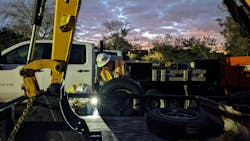Mears Broadband, a fiber optic contractor with work in Texas, Las Vegas, Phoenix, and Colorado Springs, had a huge problem. The company’s equipment department recorded a nine-figure loss in 2022.
There were other issues, too.
“Guys without CDLs were driving larger pickups and pulling trailers,” says Gil Gilbert, CEM, who was Mears Broadband’s fleet manager until recently joining ASN Constructors. “There was equipment that had telematics, but maybe 30% of the units didn’t work and didn’t report. They didn’t make all their subs and visiting mechanics wear PPE.”
More on Mears?
- How Mears Broadband uses its turnkey service with customers
- How to handle challenges of BEAD, the Broadband Equity Access and Deployment Program
There’s more. Equipment maintenance was often up to individual crews, resulting in a scattershot approach that sometimes led to major failures. And there were employees ordering their own pricey pickup trucks directly from vendors.
“We had guys out there going to individual companies and ordering their own pickups, getting fancy pickups at $1,800 a month,” Gilbert says. “And they were charging back $480, the internal rate—sometimes.”
Gilbert, a former Construction Equipment/AEMP Fleet Masters Award winner from his days with Henkels & McCoy, was brought in from Mears’ pipeline division after a year there to solve the problems at Broadband.
How did Gil Gilbert win his first Fleet Masters Award?
“It was out of control. That’s why they had me come over.” Equipment rates revealed that only 47% of overall costs were being recovered.
How to recover lost fleet costs
Partnering for Fleet Excellence
For more than 20 years, AEMP and Construction Equipment have partnered to highlight the best in heavy equipment fleet management through the Fleet Masters award program.
The men and women working for these exemplary companies stand as an example of all of the hard work and dedication it takes to be called a Fleet Master.
Technology and innovation are driving this industry forward, but it takes insight and experience from these industry professionals within some of the most successful construction companies in the world to manage this progress for the betterment of business operations.
This recognition is presented to outstanding equipment professionals who excel in meeting the unique challenges inherent in cost-effective, efficient, and effective management of mixed fleets. Two categories of Fleet Master are based on estimated fleet replacement value (ERV): less than $100 million ERV and more than $100 million ERV. The competition is open to the entire industry; membership in AEMP is not a requirement.
Fundamental, systemic problems had escalated quickly to become costly.
“They were having catastrophic losses,” Gilbert says. “The costs were not being put in the right buckets. It was all just going to an indirect account, which meant that they showed a loss, but they had no idea where they were losing it. So forensically, I had to go back in and dig through a lot of records to find out exactly what was going on.”
Gilbert worked with the finance group to start building cost codes to establish the right accounts to put costs in. He also had to work with accounting to nail down details on costs and income.
“Instead of having the large loss, we finally knew where the money was going,” Gilbert says. “It wasn’t lost, it was just on projects and then was able to be billed out. For a time, Broadband had nobody that knew how to build rates. They were just using rates they were getting through other people, publications, and Quanta [the parent company].”
Examining the company’s rental equipment was also revealing. The fleet of HDDs, backhoe loaders, mini excavators, skid steers, pickup trucks, and vacuum excavators included a mix of owned and rented equipment.
“Another problem was they were charging owned rates on rented equipment. They were losing big money on rented equipment,” Gilbert says. “They had hydro trucks, [vacuum] excavator trucks that they were renting for $14,000 or $15,000 a month. But their internal rate was $2,000 a month—so they were losing that much money every month.”
Want to learn more about setting accurate rates?
The total ballooned from there. This happened with several trucks, according to Gilbert, amounting to hundreds of thousands of dollars. Billing at the job level was inconsistent, too.
“They were supposed to be automatically billed 40 hours a week for each job. That didn’t always happen,” he says. “They were supposed to put it on a field ticket from software the foremen would use, and when they would go in and fill out the time for their crews, they’re also supposed to fill out the time for their equipment. But that would get neglected all the time. Some equipment was being used but never listed and billed out.”
Gilbert learned more as he peeled back successive layers of the onion.
Another issue was utilization. Right-sizing was necessary. “They had over 200 pieces of rented equipment,” Gilbert says. “Some of that equipment was just sitting. We made a strong push during that year to eliminate them. I eliminated 75 pieces immediately. Just sent them all back.
“Once we found out what was going on, it was a matter of building policies and processes and really putting a tracking system together—a tracking system for maintenance—everything,” he says. KPIs were introduced across the board.
How to use telematics to track costs
Telematics use was incomplete, to say the least, with the significant number of machines that weren’t reporting.
“I made it one of my staff’s KPIs to watch non-reporting units,” Gilbert says. “If we had more than 10% that weren’t reporting, that would be a problem in that group. Now, everything is up to 98, 99%.”
As for the maintenance that varied with each crew, it wasn’t that crews weren’t familiar with preventive maintenance. “They’ve seen PM rules, but they haven’t had anyone hold them accountable,” Gilbert says. “Some foremen were good, others not so good.”
With PM practices put in place, average downtime was reduced from 13 days to 1.7 days.
There were safety problems, as well. Driver cameras, facing both ways, were put in on-road stock, and a safety moment was required at the beginning of every meeting. Everything was recorded to establish trends for training and awareness.
“They had a terrible problem with collisions,” Gilbert says. “A lot of people had the mentality, ‘It’s a company truck, it doesn’t matter. It’s disposable.’ That is one of the key things; you have to break that culture. It was between that and a terrible culture with wearing PPE. Even in a yard or shop, you need to wear your PPE.”
The “disposable” attitude needed correction and a reminder that there’s an inherent cost to that way of thinking.
“Anytime you try to control costs and go to certain groups, operations, safety, they think that you’re playing in their sandbox, and they don’t want you there,” Gilbert says. “They just don’t understand there’s a cost consequence to that fleet. Next to labor, it’s the most expensive part of any job, and if it’s not handled right, it can bankrupt you.
“Operations feels like they paid for it, it’s theirs, but they don’t realize a corporation or company has invested in that equipment and they expect a return on that investment,” Gilbert says. “Because operations uses it, they need to pay for it on an ongoing basis.”
How to overcome resistance to change
“You always have resistance from the field,” Gilbert says. “I had a boss once, he wasn’t one to give out criticism or much of anything. So, I asked him, ‘How am I doing? And he said everybody hates your guts, you’re doing great!’”
Many at Mears embraced the changes Gilbert implemented, but there were instances of resistance.
“One of the biggest arguments I had was with a VP on the operations side who felt like he shouldn’t be charged an hourly rate for that equipment,” Gilbert says. “[He told me] ‘I already paid for it. Why would I have to do it again?’ They just don’t understand. It’s getting over those thoughts and ideas they have.
“To sit and argue with somebody is like wrestling a pig,” Gilbert says. “The dirtier it gets, the more they like it. What I do is try to coach them, and also make them think [the change is] their idea. And when you start breaking it down to them, they understand.”
Gilbert showed detailed examples of costs to make the financial light bulb go on for others.
“I showed pieces of equipment and how much money the company was spending maintaining and controlling it, all this stuff. Suddenly there was interest because I built a rate builder,” Gilbert says.
“It was a spreadsheet where you can put in the numbers, and it would kick out what the hourly rate should be. And one guy had a ball with it. He spent a whole week checking and setting rates. When I got ready to put my rates in, just to make him feel good about it, I said ‘Hey, review these, let me know what you think.’ He compared it all and loved it. He said, ‘That’s what I thought too!’”
The changes Gilbert implemented at Broadband took eight months, which seems remarkable for forensic accounting, new policies, and culture change. But that’s why he’s a Fleet Master.
Upon winning the 2024 Fleet Masters Award for small fleets (estimated replacement value under $1 million), Gilbert has become the first fleet manager to win the Fleet Masters Award with two different companies.
Although he has left Mears Broadband to work for ASN Constructors in Fargo, North Dakota, he says he speaks to colleagues at Mears almost daily.
“They have a very bright future.”
About the Author
Frank Raczon
Raczon’s writing career spans nearly 25 years, including magazine publishing and public relations work with some of the industry’s major equipment manufacturers. He has won numerous awards in his career, including nods from the Construction Writers Association, the Association of Equipment Manufacturers, and BtoB magazine. He is responsible for the magazine's Buying Files.



